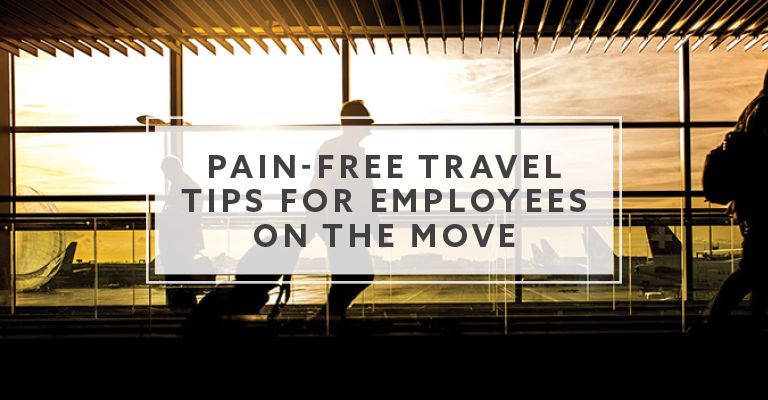You finally got your dream job! You get to do what you do best and they even pay for you to travel. It’s perfect, right? Traveling for work can be an incredible opportunity that allows you to experience new things, visit new places, and do interesting work. The only downside is that you might have to sit for long periods in cars, trains, or airplanes. This can cause pain and stiffness in different areas of your body, especially if you have a preexisting condition.
One of the biggest problems with travel is sitting in cramped spaces for long periods. The most common issues that people report are muscle tightness and pain in the neck, back, or knees. If you’ve had problems with these or any other area of your body, the thought of traveling for work might be stressful. Fortunately, there are some things you can do to reduce or avoid pain while traveling.
Full Disclaimer: We are an office furniture dealer and sell some of the products we review. To learn more about the products we sell, our review process and why you can trust us, please visit: Why we’re different. Who is BTOD.com and The Breakroom Blog?
Travel Tips for Employees Links
1. Pack Less

Packing light is the first step in pain-free travel. Most of us take too much stuff when we pack. We want to make sure that we have everything for every possible situation that might arise while we’re away. We think we’re just being prepared, but it leads to extra luggage and bags that are too heavy to lift safely.
Pulling and carrying multiple bags through an airport puts a lot of strain on your back and neck. Lifting heavy bags into an overhead bin places you at risk for shoulder injuries.
There are many online resources that offer guidelines for minimalist packing, but the basic idea is to take only the items that you know you will need. You should use a smaller suitcase that will prevent over packing. Backpacks make great carry-on bags because of their storage capacity and ability to be carried on both shoulders. Messenger style carry-on bags can place too much strain on one side on your body.
2. Use Good Posture and Body Mechanics 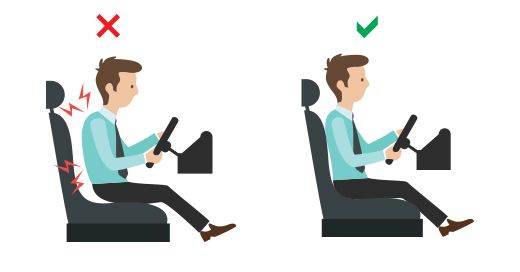
Poor sitting posture and bad body mechanics are common causes of pain during travel. Most automobile and public transportation seats don’t support your low back properly. They encourage a slumped sitting position that flexes your lower back and rounds your shoulders.
The result of this slumped position is increased strain on your spinal column and the muscles that support it. Your low back ends up in a hammock position as your lumbar spine flexes with increased compression through the spine. There is more pressure on the back of the discs that can lead to irritation of the muscles, ligaments, discs, or nerves.
You can prevent these problems by adopting good postural habits and using proper body mechanics to lift your luggage. It is best to sit all the way against the back of the seat to give the lower spine better support. If the seat is too deep for you to reach the seatback, put a small pillow, lumbar support, or folded jacket in the small of your back to take up the space. This will also keep the front edge of the seat from pressing into the backs of your knees.
When lifting luggage, use your legs to perform most of the work. Bend your knees and lower your body while keeping your spine relatively straight. Hold the bag close to your body as you use your legs to return to a standing position. Avoid twisting your trunk when lifting – especially when you are bending over. This rotational force combined with spinal compression from holding the bag can cause injury to the back.
3. Get Some Support
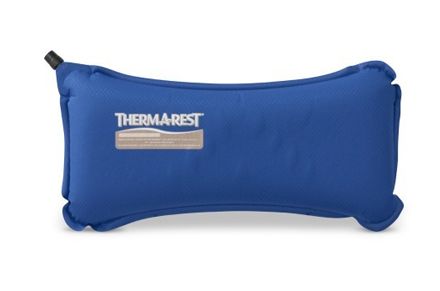 It’s hard to maintain perfect posture for long periods of time so sometimes you need a little extra support. Using a lumbar support or small pillow against the low back will reduce strain on the lower spine during your trip. There are many types of lumbar pillows and rolls available, but an inflatable support might be easier to pack.
It’s hard to maintain perfect posture for long periods of time so sometimes you need a little extra support. Using a lumbar support or small pillow against the low back will reduce strain on the lower spine during your trip. There are many types of lumbar pillows and rolls available, but an inflatable support might be easier to pack.
If you like to sleep while traveling, a horseshoe-shaped neck support is a great way to avoid waking with a stiff and sore neck. They are also available as pillows or inflatable cushions. Either form is easy to use and store in your carry-on bag.
4. Take a Break and Walk It Off
One of the best ways to avoid pain while traveling is to change positions or take breaks from sitting as often as possible. Get up and walk around for a few minutes before returning to your seat. If you are unable to walk for a few minutes, for example on an airplane, standing can be almost as helpful.
Walking breaks are relatively easy if you travel by train or car. A train allows you to walk back and forth through the cars to stretch your legs and get the blood flowing to the muscles. If you are traveling by car, make a pit stop every two hours. During your stop, walk around for at least a few minutes before returning to the car.
5. Stretches
Sitting for hours in cramped seats in an airplane, train, or car can cause significant tightness in your hips and knees. The most common muscles involved are the hip flexors, hamstrings, and calf muscles. You might also experience intermittent muscle cramps in these areas. The best way to prevent this is to perform these stretches throughout your trip.
Hip Flexor Stretch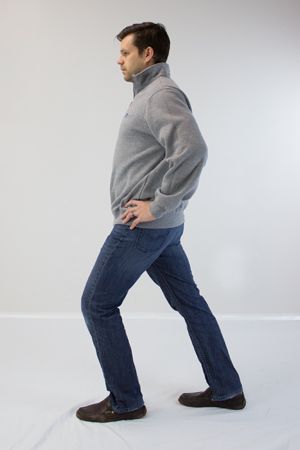
- Stand with the left foot forward and the right foot back
- Place your hands on your hips
- With your trunk straight, shift your weight toward the front foot
- Keep your back foot on the ground to maximize the stretch
- As you shift your weight forward, you should feel a gentle stretch in the front of the right thigh and hip
- Hold the stretch for 20-30 seconds, then repeat 3-4 times; switch feet and repeat the exercise
Seated Hamstring Stretch
- While seated, rest your heel on the floor with your knee straight
- Gently lean forward until a stretch is felt behind your knee/thigh
- You should keep your low back straight to focus the stretch on the hamstring muscles
- Hold the stretch for 20-30 seconds, then repeat 3-4 times on each leg
Calf Stretches – Upper and Lower Calf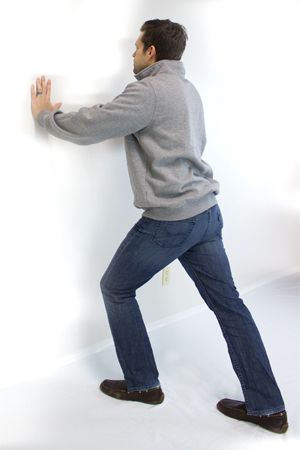
- While standing and leaning against a wall, place one foot
back behind you and bend the front knee - Your back knee should be straight the entire time
- Shift your weight forward until you feel a gentle stretch in the upper calf of the back leg
- Hold the stretch for 20-30 seconds, then repeat 3-4 times; switch feet and repeat the exercise
- To focus on the lower calf, bend the back leg slightly until you feel the stretch in the lower part of the calf muscle
Bottom Line
If you do experience pain and stiffness while traveling, heating pads, cold packs, and over-the-counter NSAIDs can help to relieve your symptoms. The stretches described above can also be used as part of your conservative treatment. If you follow these guidelines, you should be able to travel pain-free with any mode of transportation. It will make your trip more enjoyable and improve your ability to get your work done.


